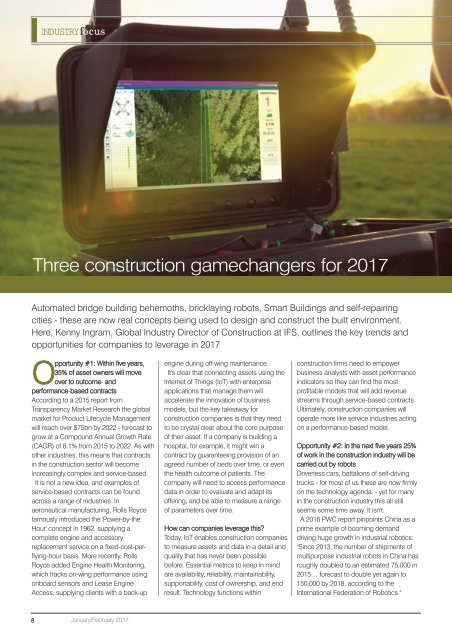CC3001
Create successful ePaper yourself
Turn your PDF publications into a flip-book with our unique Google optimized e-Paper software.
INDUSTRYfocus<br />
Three construction gamechangers for 2017<br />
Automated bridge building behemoths, bricklaying robots, Smart Buildings and self-repairing<br />
cities - these are now real concepts being used to design and construct the built environment.<br />
Here, Kenny Ingram, Global Industry Director of Construction at IFS, outlines the key trends and<br />
opportunities for companies to leverage in 2017<br />
Opportunity #1: Within five years,<br />
35% of asset owners will move<br />
over to outcome- and<br />
performance-based contracts<br />
According to a 2015 report from<br />
Transparency Market Research the global<br />
market for Product Lifecycle Management<br />
will reach over $75bn by 2022 - forecast to<br />
grow at a Compound Annual Growth Rate<br />
(CAGR) of 8.1% from 2015 to 2022. As with<br />
other industries, this means that contracts<br />
in the construction sector will become<br />
increasingly complex and service-based.<br />
It is not a new idea, and examples of<br />
service-based contracts can be found<br />
across a range of industries. In<br />
aeronautical manufacturing, Rolls Royce<br />
famously introduced the 'Power-by-the<br />
Hour' concept in 1962, supplying a<br />
complete engine and accessory<br />
replacement service on a fixed-cost-perflying-hour<br />
basis. More recently, Rolls<br />
Royce added Engine Health Monitoring,<br />
which tracks on-wing performance using<br />
onboard sensors and Lease Engine<br />
Access, supplying clients with a back-up<br />
engine during off-wing maintenance.<br />
It's clear that connecting assets using the<br />
Internet of Things (IoT) with enterprise<br />
applications that manage them will<br />
accelerate the innovation of business<br />
models, but the key takeaway for<br />
construction companies is that they need<br />
to be crystal clear about the core purpose<br />
of their asset. If a company is building a<br />
hospital, for example, it might win a<br />
contract by guaranteeing provision of an<br />
agreed number of beds over time, or even<br />
the health outcome of patients. The<br />
company will need to access performance<br />
data in order to evaluate and adapt its<br />
offering, and be able to measure a range<br />
of parameters over time.<br />
How can companies leverage this?<br />
Today, IoT enables construction companies<br />
to measure assets and data in a detail and<br />
quality that has never been possible<br />
before. Essential metrics to keep in mind<br />
are availability, reliability, maintainability,<br />
supportability, cost of ownership, and end<br />
result. Technology functions within<br />
construction firms need to empower<br />
business analysts with asset performance<br />
indicators so they can find the most<br />
profitable models that will add revenue<br />
streams through service-based contracts.<br />
Ultimately, construction companies will<br />
operate more like service industries acting<br />
on a performance-based model.<br />
Opportunity #2: In the next five years 25%<br />
of work in the construction industry will be<br />
carried out by robots<br />
Driverless cars, battalions of self-driving<br />
trucks - for most of us these are now firmly<br />
on the technology agenda. - yet for many<br />
in the construction industry this all still<br />
seems some time away. It isn't.<br />
A 2016 PWC report pinpoints China as a<br />
prime example of booming demand<br />
driving huge growth in industrial robotics:<br />
"Since 2013, the number of shipments of<br />
multipurpose industrial robots in China has<br />
roughly doubled to an estimated 75,000 in<br />
2015… forecast to double yet again to<br />
150,000 by 2018, according to the<br />
International Federation of Robotics."<br />
8<br />
January/February 2017

















